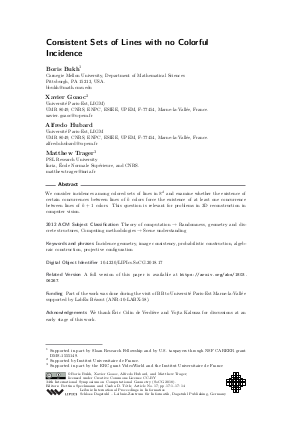Consistent Sets of Lines with no Colorful Incidence
Authors Boris Bukh, Xavier Goaoc, Alfredo Hubard, Matthew Trager
-
Part of:
Volume:
34th International Symposium on Computational Geometry (SoCG 2018)
Part of: Series: Leibniz International Proceedings in Informatics (LIPIcs)
Part of: Conference: Symposium on Computational Geometry (SoCG) - License:
 Creative Commons Attribution 3.0 Unported license
Creative Commons Attribution 3.0 Unported license
- Publication Date: 2018-06-08
File

PDF
LIPIcs.SoCG.2018.17.pdf
- Filesize: 1.01 MB
- 14 pages
Document Identifiers
Subject Classification
Keywords
- Incidence geometry
- image consistency
- probabilistic construction
- algebraic construction
- projective configuration
Metrics
- Access Statistics
-
Total Accesses (updated on a weekly basis)
0Document
0Metadata
Abstract
We consider incidences among colored sets of lines in {R}^d and examine whether the existence of certain concurrences between lines of k colors force the existence of at least one concurrence between lines of k+1 colors. This question is relevant for problems in 3D reconstruction in computer vision.
Cite As Get BibTex
Boris Bukh, Xavier Goaoc, Alfredo Hubard, and Matthew Trager. Consistent Sets of Lines with no Colorful Incidence. In 34th International Symposium on Computational Geometry (SoCG 2018). Leibniz International Proceedings in Informatics (LIPIcs), Volume 99, pp. 17:1-17:14, Schloss Dagstuhl – Leibniz-Zentrum für Informatik (2018)
https://doi.org/10.4230/LIPIcs.SoCG.2018.17
BibTex
@InProceedings{bukh_et_al:LIPIcs.SoCG.2018.17,
author = {Bukh, Boris and Goaoc, Xavier and Hubard, Alfredo and Trager, Matthew},
title = {{Consistent Sets of Lines with no Colorful Incidence}},
booktitle = {34th International Symposium on Computational Geometry (SoCG 2018)},
pages = {17:1--17:14},
series = {Leibniz International Proceedings in Informatics (LIPIcs)},
ISBN = {978-3-95977-066-8},
ISSN = {1868-8969},
year = {2018},
volume = {99},
editor = {Speckmann, Bettina and T\'{o}th, Csaba D.},
publisher = {Schloss Dagstuhl -- Leibniz-Zentrum f{\"u}r Informatik},
address = {Dagstuhl, Germany},
URL = {https://drops.dagstuhl.de/entities/document/10.4230/LIPIcs.SoCG.2018.17},
URN = {urn:nbn:de:0030-drops-87308},
doi = {10.4230/LIPIcs.SoCG.2018.17},
annote = {Keywords: Incidence geometry, image consistency, probabilistic construction, algebraic construction, projective configuration}
}
Author Details
References
-
Kalle Åström, Roberto Cipolla, and Peter J Giblin. Generalised epipolar constraints. In European Conference on Computer Vision, pages 95-108. Springer, 1996.

-
Guillaume Batog, Xavier Goaoc, and Jean Ponce. Admissible linear map models of linear cameras. In Computer Vision and Pattern Recognition (CVPR), 2010 IEEE Conference on, pages 1578-1585. IEEE, 2010.

-
Edmond Boyer. On using silhouettes for camera calibration. Computer Vision-ACCV 2006, pages 1-10, 2006.

-
Boris Bukh, Xavier Goaoc, Alfredo Hubard, and Matthew Trager. Consistent sets of lines with no colorful incidence. Preprint arXiv:1803.06267, 2018.

-
Paul Erdős and George Purdy. Some extremal problems in geometry. Discrete Math, pages 305-315, 1974.

-
Olivier Faugeras and Bernard Mourrain. On the geometry and algebra of the point and line correspondences between n images. In Computer Vision, 1995. Proceedings., Fifth International Conference on, pages 951-956. IEEE, 1995.

-
Jacob Fox, János Pach, Adam Sheffer, Andrew Suk, and Joshua Zahl. A semi-algebraic version of Zarankiewicz’s problem. Journal of the European Mathematical Society, 19:1785-1810, 2017.

-
Ben Green and Terence Tao. On sets defining few ordinary lines. Discrete &Computational Geometry, 50(2):409-468, 2013.

-
Harald Gropp. Configurations and their realization. Discrete Mathematics, 174(1-3):137-151, 1997.

-
Larry Guth. Ruled surface theory and incidence geometry. In A Journey Through Discrete Mathematics, pages 449-466. Springer, 2017.

-
Larry Guth and Nets Hawk Katz. Algebraic methods in discrete analogs of the Kakeya problem. Advances in Mathematics, 225(5):2828-2839, 2010.

-
Richard Hartley and Andrew Zisserman. Multiple view geometry in computer vision. Cambridge university press, 2003.

-
Carlos Hernández, Francis Schmitt, and Roberto Cipolla. Silhouette coherence for camera calibration under circular motion. IEEE Transactions on Pattern Analysis and Machine Intelligence, 29(2), 2007.

-
Onur Özyeşil, Vladislav Voroninski, Ronen Basri, and Amit Singer. A survey of structure from motion. Acta Numerica, 26:305-364, 2017.

-
József Solymosi and Miloš Stojaković. Many collinear k-tuples with no k+1 collinear points. Discrete &Computational Geometry, 50(3):811-820, 2013.

-
Matthew Trager, Martial Hebert, and Jean Ponce. Consistency of silhouettes and their duals. In Proceedings of the IEEE Conference on Computer Vision and Pattern Recognition, pages 3346-3354, 2016.

- Matthew Trager, Bernd Sturmfels, John Canny, Martial Hebert, and Jean Ponce. General models for rational cameras and the case of two-slit projections. In CVPR 2017 - IEEE Conference on Computer Vision and Pattern Recognition, Honolulu, United States, 2017. URL: https://hal.archives-ouvertes.fr/hal-01506996.
-
Oswald Veblen and John Wesley Young. Projective geometry, volume 1. Ginn, 1918.

